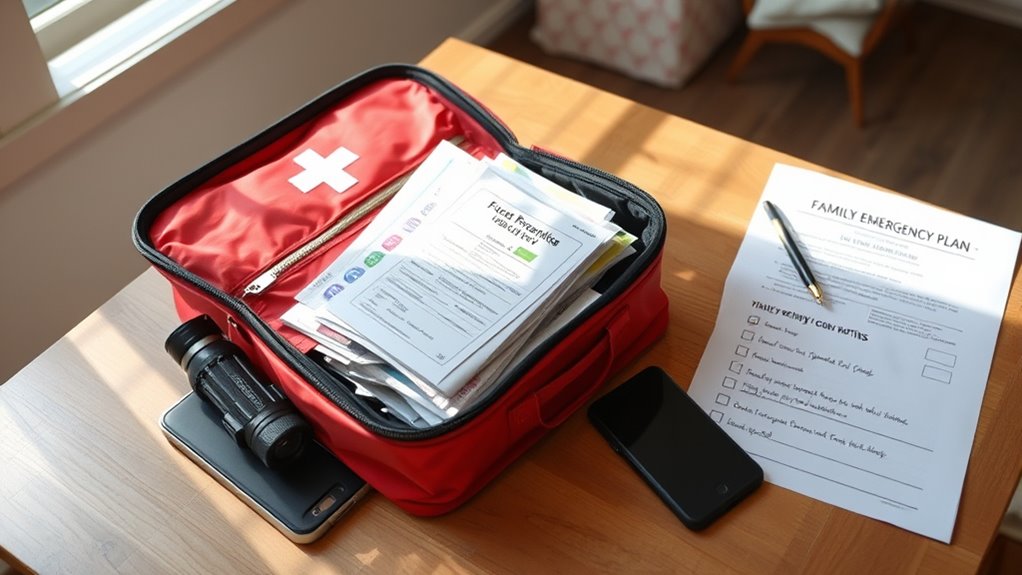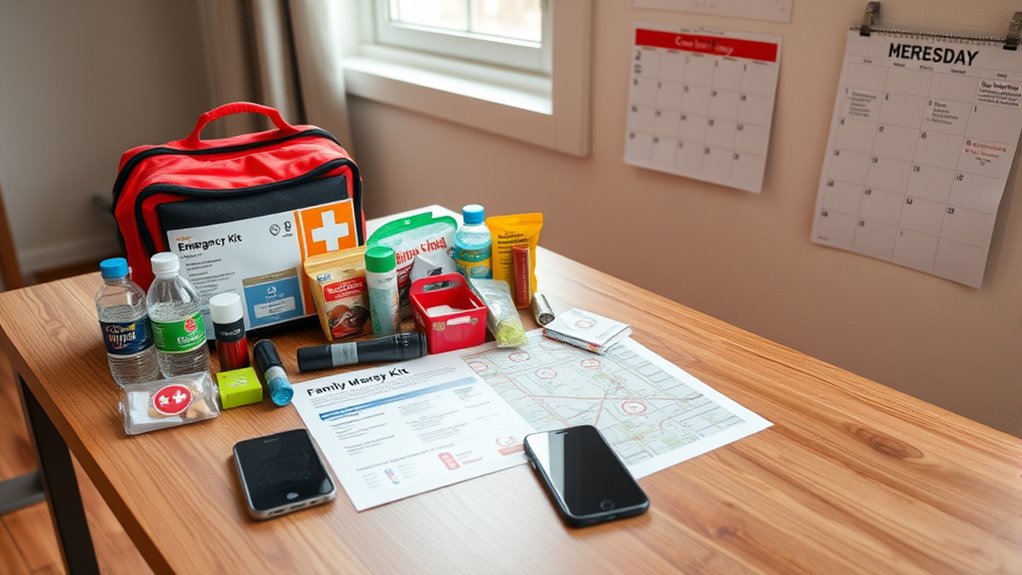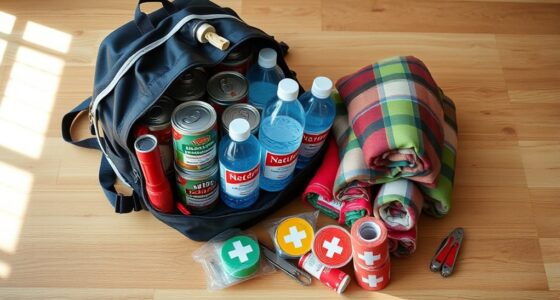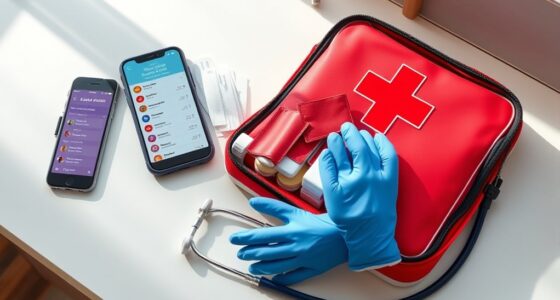To create a personalized emergency plan, start by designing clear communication strategies, like setting up a family contact plan and choosing meeting points. Identify essential supplies such as water, food, and first aid kits, and store them properly. Assign roles for household members to manage resources and communication devices. Regularly review and practice your plan to guarantee everyone knows what to do. Keep building your safety net—learn more below to strengthen your preparedness efforts.
Key Takeaways
- Develop a family communication plan with multiple contact methods and designate an out-of-area contact person.
- Identify essential resources, including supplies and important documents, tailored to your household’s specific needs.
- Establish clear meeting points near home and outside the neighborhood for reunification.
- Assign household roles for managing communication devices and resource inventory, and regularly practice the plan.
- Ensure proper storage, maintenance, and periodic updates of emergency supplies to guarantee readiness.

Having a personalized emergency plan is essential to guarantee you’re prepared for unexpected situations. When disaster strikes, quick and effective communication can make all the difference, so developing solid communication strategies is fundamental. Think about how you’ll stay connected with family members, friends, and emergency services during a crisis. Will you have a designated contact person outside your immediate area? Do you have multiple ways to communicate, such as cell phones, walkie-talkies, or social media updates? Ensuring everyone in your household understands these strategies helps prevent confusion and delays when time is critical. It’s also wise to establish a meeting point, both near your home and outside your neighborhood, so everyone knows where to go if separated.
Create a family emergency communication plan with multiple contact methods and designated meeting points.
Resource allocation is another critical component of your emergency plan. You need to identify what supplies are essential and guarantee they’re easily accessible. This includes water, non-perishable food, first aid kits, flashlights, batteries, and important documents stored in a waterproof container. Prioritizing resource allocation means not only gathering these supplies but also assigning specific roles within your household. For example, one person might be responsible for managing the communication devices, while another handles the supply inventory. This division of responsibilities minimizes chaos and ensures that every task gets done efficiently during an emergency.
You should also plan how you’ll allocate your resources over time, especially if the emergency lasts longer than expected. Stockpiling enough supplies to last several days or weeks is crucial. Consider the needs of everyone involved, including pets, and include items like medications or special dietary foods. Remember, resource allocation isn’t just about quantity but also about proper storage and accessibility. Keep your emergency kit in a designated, easy-to-reach spot, and make sure everyone knows where it is. Regularly check and update your supplies to guarantee everything remains functional and up to date. Incorporating emergency preparedness strategies and resource allocation into your personalized emergency plan ensures you’re not caught off guard. Clear communication minimizes misunderstandings, and well-planned resource management guarantees everyone’s needs are met during a crisis. By taking these steps, you create a comprehensive safety net that empowers you to respond swiftly and confidently, reducing stress and increasing your chances of staying safe. It’s about being proactive rather than reactive, so take the time now to develop, practice, and refine your plan. Preparedness makes all the difference when unpredictable events happen, and your efforts will provide peace of mind knowing you’re ready for whatever comes your way.
Frequently Asked Questions
How Often Should I Review My Emergency Plan?
You should review your emergency plan at least once a year and after any significant changes in your life or home. Conduct regular drill frequency, such as quarterly drills, to ensure everyone knows their roles. Use these drills to identify gaps and update your plan accordingly. Keep your plan current by making plan updates promptly whenever new risks emerge or circumstances change, so you’re always prepared for emergencies.
What Supplies Should Be Included in My Emergency Kit?
Your emergency kit is your lifeboat in a storm, so pack it wisely. Include essential supplies like water, non-perishable food, a flashlight, batteries, a first aid kit, and personal hygiene items. Don’t forget important documents and a multi-tool. Keep your kit organized with clearly labeled compartments so you can find what you need quickly. Regularly check and update supplies to guarantee readiness when disaster strikes.
How Can I Involve Children in the Planning Process?
You can involve children in planning by making it fun and age appropriate. Explain child safety in simple terms, and let them help choose supplies or practice emergency drills. Use activities suited to their age, like drawing escape routes or assembling their own kit. This way, they stay engaged, understand safety procedures, and feel prepared, making everyone more confident and calm during an actual emergency.
What Are Common Mistakes to Avoid in Emergency Planning?
You should avoid neglecting a thorough risk assessment and improper resource allocation. Failing to identify potential hazards can leave you unprepared, while misallocating resources might cause shortages when emergencies strike. Don’t overlook updating your plan regularly or ignoring specific needs of children and vulnerable family members. Instead, focus on realistic scenarios, prioritize safety, and guarantee all resources are accessible, so your plan remains effective and adaptable when it’s needed most.
How Do I Communicate My Plan to Family Members?
You should start by clearly sharing your plan with family members through a dedicated meeting or conversation. Use simple language to explain each step, emphasizing family communication and the importance of everyone’s role. Distribute written copies or digital versions of the plan so they can review it anytime. Confirm understanding and encourage questions to guarantee everyone is on the same page, making plan sharing effective and reassuring.
Conclusion
Now that you’ve laid the foundation for your personalized emergency plan, the unexpected still lurks around the corner. Will you be ready when it strikes? Remember, emergencies don’t wait, and neither should you. Keep your plan updated, stay alert, and trust in your preparation. The safety of those you love depends on it. Are you truly prepared to face the unknown? The moment is yours to take control—don’t let uncertainty catch you off guard.









